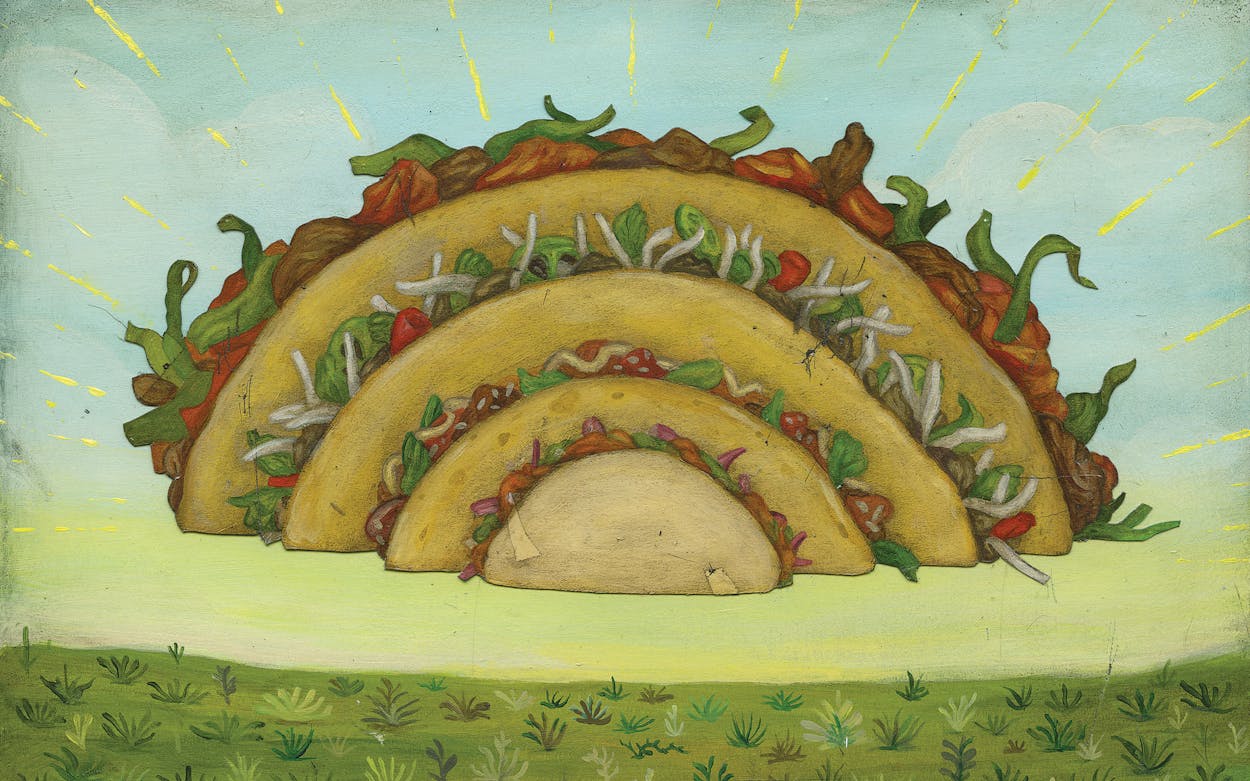Fifty years ago, the tacos most Texans ate—breakfast tacos, barbecue tacos, and crispy tacos—originated in the foodways of South Texas. Not anymore. Today tacos hail from all over and have become a vessel for cultural bridge-building in a wildly multicultural state. The taco is a culinary welcome wagon, inviting Texans to be more adventurous in their eating habits while offering immigrant diners and restaurateurs a passage into American cuisine. Immigrants from around the world and their descendants are adapting their dishes to create new fillings for the familiar tortilla. “I don’t want to say it’s easy to put something in a taco, but it’s more approachable for a lot of people,” says Anna Swann, owner of the Dallas pop-up Ulam Modern Filipino Kitchen.
For anyone raised on tacos, it’s not a huge leap to consume Swann’s signature sisig, a mixed-meat dish composed of pork head and shoulder, seasoned with onions, chiles, and citrus fruit, and nestled in a gossamer flour tortilla. It resembles discada, a mixed-meat preparation popular along the border. This isn’t exactly shocking. From the sixteenth to the early nineteenth centuries, the Philippines and Mexico, with a shared history of Spanish colonization, were connected by the trade route between Manila and Acapulco, which promoted the exchange of fruits and spices.
Yet tacos today also incorporate cuisines with which they share few connections. Umair Alem, the owner of Houston’s Twisted Turban, says the taco is exotic for many immigrants. But his native Pakistan certainly has foods that are close cousins of the tortilla, including paratha, a buttery flatbread common across South Asia. Alem uses it as an uncanny stand-in for flour tortillas. His signature dish, the Turban Taco, is packed with shredded brisket topped with vinegar-dressed cabbage for an acidic crunch that’s brightened by a helping of mango. Alem regards brisket as the ingredient that invites Texans into his establishment, which is part of the growing category of Indo-Mex restaurants.
Perhaps the most impressive example of how a foreign cuisine has deployed the mighty tortilla to gain traction in Texas is the slate of Korean tacos that can be found in all of our major cities. When Jae Kim opened his food truck, Chi’Lantro BBQ, in Austin in 2010, many diners were intimidated by his fermented, chili-marinated cabbage dish, kimchi. “It was the smell,” Kim tells me.
But today, Chi’Lantro has ten brick-and-mortar locations and one truck in Austin, with a Houston outpost opening soon. Like the foods purveyed by Ulam and Twisted Turban, Kim’s menu encourages diners to explore cuisines they might otherwise avoid, the bite of the unfamiliar spices and condiments softened by the familiar accompaniment of Texas’s go-to wrapper.
This article originally appeared in the February 2023 issue of Texas Monthly with the headline “ ‘Taco’ Is Spanish for ‘Welcome.’ ” Subscribe today.
- More About:
- Tacos









